 |
The Palca Canyon - Hiking and Tracking

After we got an impression of the lively and very busty live of the metropolis Bolivia with our city tour and after one to two days we got used to the altitude situation, our thirst of action for exploring the surroundings of La Paz is big and also to get some calmness after the hustle and bustle of the city. In our itinery, a half day hiking tour was planned through the Palca Caynon with its bizarre rock formations that is approximately at a 15 km distance from the city. It was advertised that this Canyon, even though it is far not as big as the Bryce or the Grand Canyon in the USA, is not less beautiful and unique as the other two and that in addition it was still quite unknown. And we should not be disappointed!
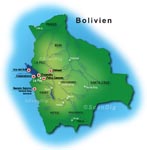
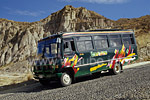
But before we can start with the hiking tour through the Palca Canyon the question about how to get to the starting point must be answered. Those who want to be on the save side can book the excursion at one of the numerous tour angents in La Paz (most of them can be found at the Calle Sagarnaga). Our tour provider Magri-Turismo (in the Calle Capitán Ravelo) was already determined by the booked journey, a thing that was not a disadvantage to us, as we were throughout the journey more than happy with our agency! Alternatively, one can hire a taxi for approximately 50 euros that takes one to the starting point and picks up one again form the ending point. The disadvantage of this possibility is that a guide who is familiar with this area, so that one has to do the way to and through the canyon by oneself and one should also have a basic knowledge of the spanish language in order to get where one wants to.
Approach through the suburds of La Paz
Thus, let us start with the approach to the starting point of the hiking tour by starting with a bus from Prado, always following the main road to the southeast. At the beginning, the drive leads us a piece through the busty centre passing a lot of modern buildings, until after an S-curve a view to the lower and extended city districts of La Paz is offered; We continue driving down the road passing a small side valley from which a brook flows that is coloured dark brown by the waste water, but some poor indio women do wash their clothes there.
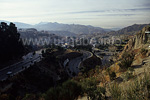
And over the hillsides of the small valley, the garbage is simply thrown down. As clean as the prado in the centre is, it is very sad to see how nature is treaten here. Further downhill, we get to the suburb Obrajes that is "only" at a height of approximately 3200m. Here, a district with european flair has developed that makes one almost forget that we are more than 12000km far from Europe. Here are different car sellers, electronic markets and furniture markets; And due to the low altitude situation, also the rich people have settled here with their beautiful villas with big gardens and additionally, here are also most of the foreign consulates.
At a big crossroads we turn to the left in direction to Calacoto and San Miguel, and from now, the way continues upwards. In numerous hairpin bends, the bus twists up, on well paved roads at the beginning, but in the district San Miguel, the layer on the road changes, first cobblestones (but not coparable with the European ones, as these are round stones and due to this, the road is respectively bumpy), soon it is only a dust road on which the buses' wheels turn around. And such an abundance of deep potholes on the road! In the bus, I choosed one of the back seats, a thing that I regreted: Any time the bus driver drove over a pothole, I sometimes was rised from my seat to such an extent that my head slapped on the ceiling...
In San Miguel, not only the road changes but also the buildings on the street. The houses get smaller and in front of almost every house there is a more or less big sales stand. At approximately 3800m, the buildings at the road edge disappear and the bus still gasps 200 altitude metres up to the Cuesta de las Animas (pass of the souls)at a height of 4000m.
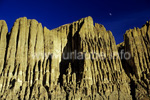
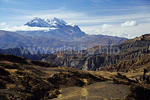
And all of a sudden, we have a powerful view offered to our eyes! The impressive massif of the Illimanis rises 2500m over the whole area! At the left, there is the 5868m heighted Mururata with its flat peak calotte but it is far not as imposing as the Illimani. There is also a history in this concern: Once, the Mururata wanted to outstand the Illimani in the height, but the Illimani hit with a sword the head of the opponent and took it hundreds of kilometres to the south, where ever since, the "head" of the Mururatas is located and therewith the highest mountain of Bolivia, the 6562m heighted Sajama. Underneath the Illimani, there is already a part of the Palca Canyon, in which we soon will hike into. We drive a little more downhill up to the Hacienda Uni that is outstood by some unique rock formations. These conglomerate pillars formed by the erosion stand in a line as organ pipes. We get off the bus at the hacienda and can finally start our hiking tour! Alternatively, one can continue the drive up to Uni, but then one will miss a third of the canyon.
Hiking tour through the canyon to Palca
After we took our rucksacks where there were enough drinks, something to eat, and despite of the sun, also some waterproof clothing, we follow our tour guide Erich, who already accompanied us during the city tour. At the beginnig, we only walk a little downhill over pastures, we see some some cows, sheeps and also donkeys trying to find something eatable on the barren ground. Due to the dry period during the winter time in Bolivia that is from May up to September, but also due to the altitude, the vegetation is quite rare, so there are only a few green plants and grasses visible. The more surprising it was when we were suddenly at a height of 3800m between the desiccated bushes and looked at a golden yellow grain field. And at the other side, some wild spiny cacti grow, the contrast cannot be bigger!
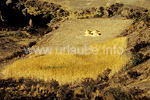
The path gets continuously more narrow and inconspicious, sometimes some young Indigenas come across us who are looking for their cattle, then the path stops and we continue pathless. Now we are happy that our guide knows this area, as, even though the way to the canyon is downhill, in this pathless area one soon loses orientation. Thus, we follow a clearly visible dried brook bed, thus it cannot be too far to the canyon. We turn around the corner and look, there is the canyon!
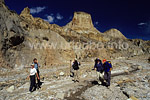
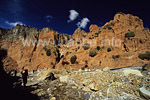
Above us, there are some vertical walls made of red-brown sandstones rise, in the most small ledges some individual bushes grow, and at this spot where the riverbed of the Rio Palca is quite wide, there are lying some round stones of different colours and sizes. I think where there is a canyon there must be also a brook that during millions of years formed this bizarre landscape through erosion. But there is far and wide no water visible. When we asked Erich where the water is, he answered that we should be happy that we are hiking through this area during the dry period, as during the rainy season, so much water would flow in the river that the canyon is impassable. By looking at the unique rock formations, one wonders how could this all be originated? To answer this, we will have now a small excursion into the geology.
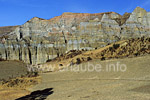
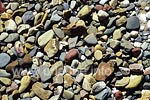
As the Alps, the Andes and the Himalaya are, compared to the earth history, quite young mountains. Approximately 150 millions years ago, the Nazca-plate (located under the Pacific) started to move under the continental Southamerican plate, a thing that is called subduction in the geology. Thereby, two deep-sea trenches were originated, the Peru trench and the Atacama trench. As in the subduction areas, a huge pressure and compression originates, many times there areŽ earthquakes in these areas. But don't worry, the Altiplano in Bolivia is located so far from these areas that earthquakes are really seldom. In the so-called tertiary about 60 million years ago, through a further subduction, the uplift and the folding of the Andes began. Thereby, some high mountains of a length of 7500km and a width of 600km that have their culmination point in the 6958 heighted Anconcagua were originated by the raised up lava, but also by the ascend of lighter stone areas that were formed during the subduction in the inner earth.
While this mountain formation, a so called depression developed between the north and the west cordilleras, a lowering similar to a trench developed, the Altiplano. The Altiplano trench was then further filled with clastic erosion sendiments (sandstone, argillaceous schist, quarzite) of the cordilleras, whereby a massive continental sequence of layers up to 10km were originated. As the surroundings of La Paz are located at the edge of the Altiplano, where it falls into the Bolivian lowlands in direction to the east, the conditions are optimal for the origination of a canyon. At the hillsides, some rain and melt water collects and searches the way down, whereby it diggs through the relatively soft sandstone- and conglorimental layers and by this way, in the course of the millions of years, modelled this impressive beauty of nature.
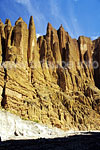
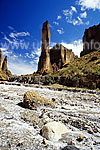
After this small excursion we come back to our hiking tour. We get to a place where the canyon gets narrow and some bigger stones block the way. Jumping from one stone to the other, and I feel to be back in my childhood when I attacked almost every dried mountain brook, we overcome this obstacle. After this spot, a path appears from the left, that begins in Uni, downhill. The canyon widens again and a new view is opened to us. Several hundred metres heighted rock walls in ocre rise now above us, we repeatedely gaze upwards, we pass a rock tower that rises to the sky as a sky scraper. I cannot stop photographing, I am really impressed about the photo motifs offered, I shoot film by film with my reflex camera, and I cannot stop being amazed by the spectacular scenery offered, I do not notice anymore the cold wind that blows to our faces although the sun shines.
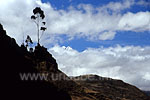
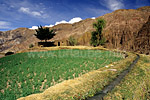
We follow the curves of the riverbed, after some long time we come across again to a hardly recognizable path, apparently a shepherd's path, as an old man approaches us with his sheeps and we wonder where the animals get some food in this wasteland. But apparently a little green stuff that grows despite of the dry and stony ground is enough for the sheeps. At the left, a single eucalyptus tree clips at a ledge, and there behind suddenly the peaks of the Illimani covered with snow appear that outstand the canyon by more than 3000m, for a short time from the clouds. After a short rest where we had a lot to drink and something to eat and put some lotion on our faces as the sun radiation is very strong, we start or last way of 45 minutes up to our destination Palca where the bus picks us up.
After we got recoverd and restarted our walk, the canyon got wider and the walls became lower, there is again some green vegetation visible and even some cows border our way. We went downhill all the time but now a wide path at the left leads us upwards. We pass a planted fields that seems shining green as a jewel in this scarce and life-threatening area. The reason of this fresh green colour: The field is provided with the needed water ba an open irrigation canal. Beside, some peasants cultivate and plough in laborious handcraft their modest fields on which in this area almost potatoes, sweetcorn, quinoa and cereals are cultivated. Time seems to stand still here and one feels centuries back by looking at the people working.
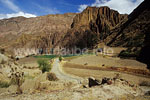
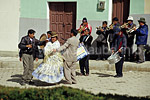
On the last metres to Palca that is located at approxiamtely 3200m, thus we have been walking down some good 600 altitude metres, the way leads through a clear forrest with eucalyptus trees, and soon, the first houses are visible. by turning around a corner we already see the bus driver waiting for us. We get into the bus and drive to the lovely village plaza of this place; No deteriorated houses are standing around the centre as expected, there are modern buildings with recently painted claddings. Erich explains us amazed tourists: Palca is rich due to a precious metal that is gold that is washed in the brooks around the place. And we can get "lively" convinced that the population does not consider it to be importasnt to work on a Monday. The whole village seems to be active, people dance and laugh, the wind music plays one of the very typical Bolivian marchs (honestly, a Bavarian band sounds much better), and endless amounts of beer are drunk. A very fascinating and funny bustle on a working day!
Return to La Paz and short side trip to the Valle de Luna
After the for us Europeans unusual experience we get into the small bus and return in direction to La Paz. We drive through some eucalyptus forests that after some time turn into farmland. Some single cars approach us on the bone-dry road, well rather the pothole piste. Such an encounter always makes the pulse get faster, as the road is just as wide that two vehicles can pass each other. There are no crash barriers as it is the way on European roads, from the road edge there is straihght a depth of several hundred metres. At a specially exposed spot I discover a car wreck in the depth, and beside the road some flowers and candles... The best is simply not to look downwards and not to think about what would happen and trust the driver. The bus twistes in countless hairpin bends upwards, we pass some individual houses and are shaked back and forth in the interior of the vehicle, and finally reach the 4000m mark and again the Cuesta de las Animas.
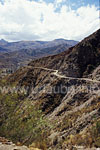
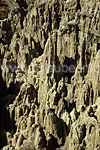
On an already known path we drive through the suburbs San Miguel and Obrajes up to the big crossroads, at which we turned to the left from the main road of the morning. And there, our half day excursion through the Palca Canyon ends.
Even though during the hiking tour we mostly walk downwards, our tummies rumble and we really deserved a lunch meal! Here, the Hotel Oberland in the small place Malassa is recommendable. Oberland? Is this a german word we hear? Yes! Those who already read the article about La Paz will know that this hotel is managed by the Swiss man Walter Schmid and that we had there the already mentioned lunch. Several meat specialities were served and additionally sweet corn, sweet potatoes and maniok. And, as usual, a chilled cerveza!
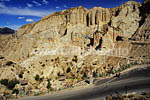
After this abundant and also exquisite meal, a short side trip to the nearby Valle de Luna (moon valley) is worthwhile. The way to there is very well signposted, the entrance is above the cacti garden that is located at the street. We access a landscape that really looks like the surface of a moon. Bizarre earth- and stone towers, column pyramides and rock mushrooms grow upwards the sky, that in the course of the milleniums were originated by the erosion and the climate contrasts. Unfortunately, the major part of this nature beauty has been destroyed in the recent years by the intensive cultivation. Those who are fans of golf sport can play on the highest located golf course of the world nearby. Or, for the animal lovers, there is the possibility to visit the zoo of La Paz. But we get again into our bus and drive the approach way back to the centre of La Paz and to our hotel. Once arrived there, we relax by having a cocatea, let the day pass in review and get into the mood of the trip of tomorrow to the ruins of Tianaku and to the Titicaca Lake.

Back to the index Bolivia
Author: Flori Forster; Copyright: Patrick Wagner, www.tourist-guide.biz
|
 |